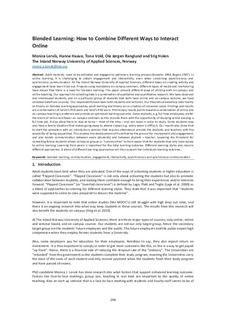| dc.contributor.author | Lervik, Monica Johannesen | |
| dc.contributor.author | Haave, Hanne Marit | |
| dc.contributor.author | Vold, Tone | |
| dc.contributor.author | Ranglund, Ole Jørgen Stefferud | |
| dc.contributor.author | Holen, Stig | |
| dc.date.accessioned | 2018-02-15T08:41:31Z | |
| dc.date.available | 2018-02-15T08:41:31Z | |
| dc.date.created | 2017-10-31T08:51:35Z | |
| dc.date.issued | 2017 | |
| dc.identifier.citation | European Conference on e-Learning. 2017, 298-303. | nb_NO |
| dc.identifier.issn | 2048-8637 | |
| dc.identifier.uri | http://hdl.handle.net/11250/2484880 | |
| dc.description.abstract | Adult students need to be activated and engaged to optimize a learning process (Knowles 1984, Rogers 2007). In online learning, it is challenging to obtain engagement and interactivity, even when combining asynchronous and synchronous communication. At The Inland Norway University of Applied Sciences, different takes on creating activity and engagement have been tried out. Projects using mandatory on-campus seminars, different types of media and live tutoring have shown that there is a need for blended learning. This paper present different ways of utilizing both on-campus and online teaching. Our approach to collecting data is a combination of qualitative and quantitative research. We have observed and interviewed students, and on a particular group of students that both have online and on-campus lectures, we have collected data from a survey. Our respondents have been both students and lecturers. Our theoretical backdrop rests mainly on theory on blended learning approaches, adult learning and theory on co-creation of consumer value. Findings and results are a combination of Lervik’s PhD work and Vold’s PhD work. Preliminary results points towards a combination of online and on-campus teaching is preferred and provide an optimized learning outcome. Some students, e.g. full time employees, prefer the blend of online and fewer on-campus seminars as this provide them with the opportunity of studying whilst keeping a full time job. It also allow them to stay at home – most of the time – and not move in order to study. Some students may also have a family situation that makes going away to attend classes e.g. every week is difficult. Our results also show that to start the semesters with an introductory seminar that requires attendance provide the students and teachers with the possibility of being acquainted. This enables the development of trust that lay the ground for involvement and engagement, and also boosts communication between peers (students) and between student – teacher. Lowering the threshold for contacting fellow students allows colloquial groups or “communities” to form easier that for students that only have Access to online learning. Learning from peers is important for the total learning outcome. Different learning styles also require different approaches. A blend of different learning approaches will thus support the individuals learning outcome. | nb_NO |
| dc.language.iso | eng | nb_NO |
| dc.rights | Attribution-NonCommercial-NoDerivatives 4.0 Internasjonal | * |
| dc.rights.uri | http://creativecommons.org/licenses/by-nc-nd/4.0/deed.no | * |
| dc.subject | blended learning | nb_NO |
| dc.subject | communication | nb_NO |
| dc.subject | engagement | nb_NO |
| dc.subject | interactivity | nb_NO |
| dc.subject | asynchronous and synchronous communication | nb_NO |
| dc.title | Blended learning: How to combine different ways to interact online | nb_NO |
| dc.type | Journal article | nb_NO |
| dc.type | Peer reviewed | nb_NO |
| dc.description.version | publishedVersion | nb_NO |
| dc.source.pagenumber | 298-303 | nb_NO |
| dc.source.journal | European Conference on e-Learning | nb_NO |
| dc.identifier.cristin | 1509126 | |
| cristin.unitcode | 209,98,60,2 | |
| cristin.unitcode | 209,98,60,1 | |
| cristin.unitname | Institutt for Økonomifag | |
| cristin.unitname | Institutt for organisasjons- og ledelsesfag | |
| cristin.ispublished | true | |
| cristin.fulltext | original | |
| cristin.qualitycode | 1 | |

